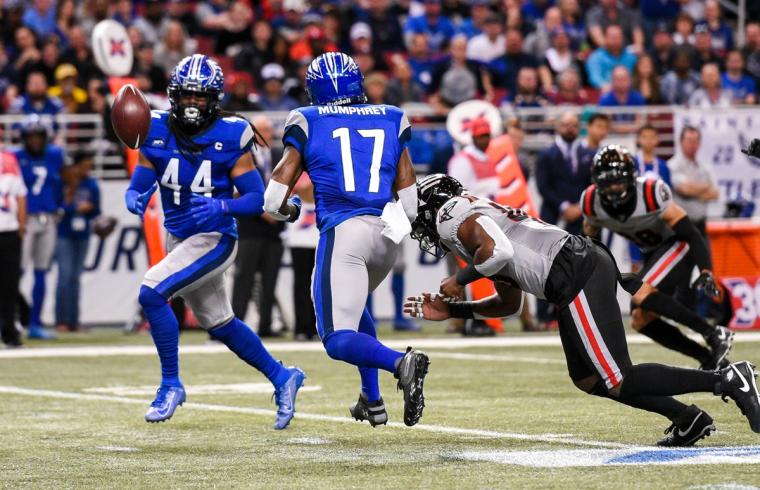
After two USFL seasons and one XFL season, the two fledgling spring football leagues are merging. Teams will begin play as the United Football League on March 30, when the 2023 champions of each former league — the USFL’s Birmingham Stallions and the XFL’s Arlington (Texas) Renegades — kick off the inaugural 10-game UFL season.
Calling itself “the premier spring football league,” the UFL will debut with eight teams divided into two conferences: USFL and XFL.
The XFL Conference will feature four teams from that former league: Arlington Renegades, D.C. Defenders, San Antonio Brahmas and St. Louis Battlehawks.
The USFL Conference, meanwhile, will feature three existing teams from the former league: Birmingham Stallions, Memphis Showboats and Michigan Panthers. The conference’s fourth team will be the Houston Roughnecks, a rebranding of the USFL’s Houston Gamblers. Houston was the only overlapping market in the former leagues, and UFL officials said it also was one of the strongest.
 “That leaves several teams — the XFL’s Orlando Guardians, Seattle Sea Dragons and Vegas Vipers, and the USFL’s … New Jersey Generals, New Orleans Breakers, Philadelphia Stars and Pittsburgh Maulers — [that] will be dissolved, with the players under contract to those teams subject to a dispersal draft,” according to Yahoo.com.
“That leaves several teams — the XFL’s Orlando Guardians, Seattle Sea Dragons and Vegas Vipers, and the USFL’s … New Jersey Generals, New Orleans Breakers, Philadelphia Stars and Pittsburgh Maulers — [that] will be dissolved, with the players under contract to those teams subject to a dispersal draft,” according to Yahoo.com.
Russ Brandon, former president and CEO of the XFL, will lead the UFL as president and CEO. Daryl Johnston, former USFL president of football operations, will lead football operations.
Dwayne “The Rock” Johnson, purchased the XFL (which previously played one season, in 2001) with his ex-wife Dany Garcia from original league owner Vince McMahon in 2020. The USFL, meanwhile, had a three-year run in the early Eighties before it’s resurrection in 2022 and now is owned by Fox Corp.
Forbes.com reported that the revamped XFL lost an estimated $60 million during its inaugural season in 2023 but projected $100 million in revenue for the 2024 season. Additionally, the average number of viewers for USFL games across Fox, FS1, NBC and USA Network last season was 751,000; the XFL averaged 627,000 viewers.
News of a pending merger of the two leagues surfaced in September, but the official announcement came on New Year’s Eve via a segment on FOX NFL Sunday. Fox, as well as ESPN, ABC and Fox Sports 1, will broadcast UFL games.
“If you think about it, this [has been] 30 years of spring football starting and stopping, starting and stopping,” Johnson said on FOX NFL Sunday. “So this merger between USFL and XFL feels like we’ve got a shot to establish that spring football is here to stay.”
Spring football has never caught on in the United States, as evidenced by the All American Football League (2010, ever so briefly), the Stars Football League (2011-13), the Alliance of American Football (2019, barely) and an organization that also went by the name United Football League (2009-12).
Which means this could be the sport’s final spring stand.
“Barring another attempt by the NFL to fully fund a pro football league in its offseason, the newly-merged United Football League provides one last hope for long-term viability,” noted FanNation, part of the Sports Illustrated Media Group. “Both the USFL and XFL have friendly relationships with the mighty NFL, and have served as proving grounds for not only players but officiating and innovation. But you can’t assume that the NFL will come in and save the day by fully financing the UFL. This is it. If this doesn’t pan out, [i]t’s hard to envision another pro league coming along with the cache or backing that this one has. If this fails, how can others succeed?”
Last May, after the XFL attracted nearly 23,000 fans to the XFL’s championship game between the Renegades and the Defenders at San Antonio’s Alamodome (and drew an average of 1.43 million viewers), The Sporting News made a side-by-side comparison of both leagues and seemed to predict where things stand now:
“The USFL has the XFL edged ever-so-slightly in the battle for spring league superiority,” concluded Jacob Camenker. “Why? It’s all about the broadcast. That is the way that most football fans consume the sport, so given the USFL’s innovative angles and the presence of [acclaimed analyst Joel] Klatt among its on-air talent, that is the prime differentiating factor between the two leagues. That isn’t a slight to the XFL by any means. They certainly have the star power … needed to thrive in the spring football space. And, in fact, there are plenty of pros for both the XFL and USFL that suggest that one — or both — of the spring leagues can survive long-term.”

